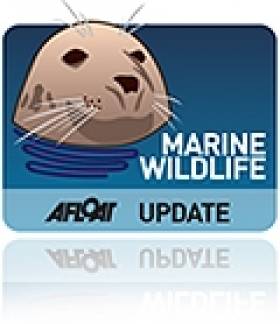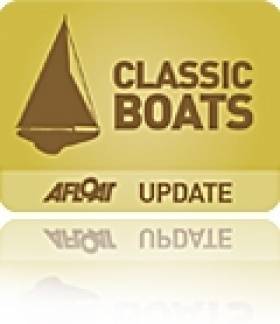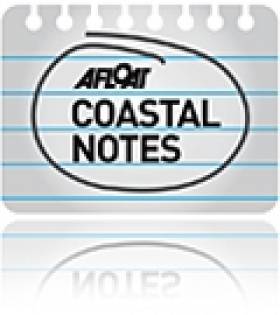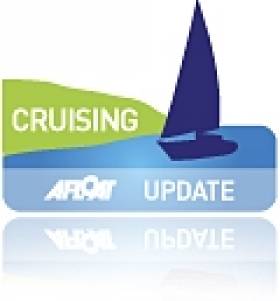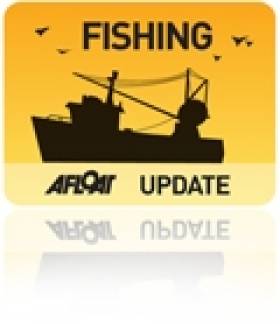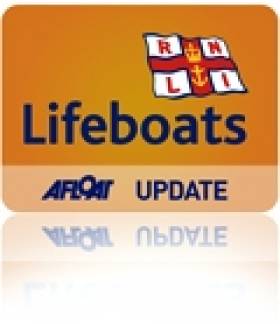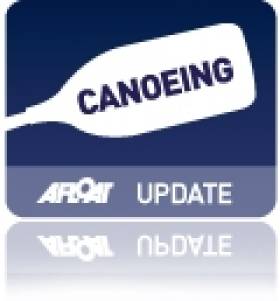Displaying items by tag: west cork
#TitBonhomme - RTÉ News reports that the families of two Egyptian fishermen who died in the Tit Bonhomme tragedy in West Cork three years ago last week settled their civil actions in the High Court.
Saled Mohamed Ibrahim Aly Eldin and Attia Shabaan were two of four Egyptian fishermen on the Union Hall fishing trawler that sank after running aground in rough seas near Adam's Rock at Glandore Harbour on 15 January 2012.
The incident took the lives of skipper Michael Hayes and fellow crew Kevin Kershaw, whose family settled an action in early 2013, and Wael Mohamed, whose family settled their own High Court action earlier this month.
The latter's brother Abdelbaky Mohamed was the only survivor, and gave testimony at the inquest into the incident in the summer of 2013, which returned verdicts of accidental death. RTÉ News has more on the story HERE.
Hayes' widow Caitlin Ní Aodha has since returned to the fishing industry and spoke to our own Tom McSweeney for his This Island Nation show in October last year.
First Basking Sharks Of 2015 Spotted Off West Cork
#MarineWildlife - The first basking shark sightings of 2015 were logged earlier this month, as Ireland's Wildlife reports.
Bridget Healy spotted two of the ocean's second-largest fish from the shore at Ardfield, near Clonakilty in West Cork last Monday 9 March – a little earlier than they usually appear.
But it's still some time off their peak numbers expected between May and June, when the gentle giants might come closer to the shore like one did in Cork Harbour last summer.
Ireland's Wildlife has more on the story HERE.
Retired Teacher Drowned After Sailboat Overturned, Inquest Hears
#Zillah - The inquest into the death of a retired schoolteacher in a sailing accident off West Cork last summer has heard he was "very safety conscious".
As previously reported on Afloat.ie, the body of 66-year-old Douglas Perrin was recovered from the water near Sherkin Island on the morning of 14 August 2014 after a 12-hour search and rescue operation.
Coroner Frank O’Connell returned a verdict of accidental death, noting the cause of death as acute cardiac failure brought on by drowning.
Two companions, Marian Brown and Patrick Anwyl, were found alive on nearby Castle Island after swimming away from the capsized sailboat the three had been travelling in the day before.
Bandon Courthouse was told that Perrin had purchased his boat Zillah, a 24ft Drascombe Lugger, two years before retiring from Oxfordshire to Goleen in Co Cork in 2013, according to the Irish Examiner.
The party – each with a lifejacket – had set out for a short excursion at 4pm, planning to return in time for a 7pm dinner, when the boat overturned under the control of Anwyl in gusty weather.
"We were about 50 yards from an island, collectively we discussed it and started to swim," read a statement from Brown, who added that when the swell subsided, she and Anwyl managed to clamber onto the rocks, from where they saw Perrin "lying passively in the water, just drifting."
Later, Brown recalled an Irish Coast Guard helicopter sweeping the area with its search beam but failing to spot the pair, who were eventually met by crews from the Schull inshore lifeboat and Baltimore RNLI the following morning.
The Irish Examiner has more on the story HERE.
Simon Coveney to Nail 'Ilen's' Whiskey Plank at West Cork Ceremony for Ireland's Last Traditional Sailing Ship
#ilen – Simon Coveney T.D. Minister for Agriculture, Food & The Marine and Minister For Defence will hammer home the final 'whiskey plank' of European larch on the hull of the good ship Ilen on Monday, 16th February.
The whiskey plank is the final crafted plank nailed to the hull of a wooden sailing ship. It is a significant milestone in the build and is traditionally marked by a celebration.
The Ilen is the last of Ireland's traditional sailing ships. Built in 1926, it was delivered by Munster men to the Falkland Islands where it served valiantly for seventy years, enduring and enjoying the Roaring Forties, the Furious Fifties, and Screaming Sixties.
Returned now to Ireland and given a new breath of life with powerful ribs of grown Irish oak, and long planks of European larch from our gallant allies in the Bavarian Alps, she pitches impatiently in the trammels of the great Corn Store in Hegarty's Boatyard, as eager as a young salmon to get to the sea.
West Cork Weather Buoy Records Second Highest Wave
#WaveRecord - The M3 weather buoy has measured the second highest wave ever recorded off the West Cork coast, according to The Skipper.
The buoy measured an individual wave of 16.9 metres at 10am last Thursday 15 January in the midst of Storm Rachel, a little over two metres shy of the 19.1m wave recorded on 27 January 2013.
The Coast of West CorkThe stormy conditions have seen consistent but unusually high seas this month so far, with the M3 buoy - which was swept away to Devon in storms two years ago – recording an average Significant Wave Height of over six metres.
Meanwhile, in the Irish Sea the M2 buoy recorded an individual wave of 8.7m at 10pm on 14 January, just 18cm below the record set on 27 December 2013.
Old Gaffers Plan West Cork Cruise Along The Fastnet Coast
#westcork – The Irish President of the Old Gaffers Association is organising a sailing cruise along the West Cork coast in July with venues to include well known harbours and landmarks along the 'Fastnet coast' such as Skellig Michael via Baltimore, Schull, Crookhaven, Castletownbere, and Adrigole.
In setting out plans for the cruise in company, an upbeat OGA chief Sean Walsh says West Cork caters for inclement weather by providing some of the 'best havens in the world', where 'enjoying creamy pints on a tall stool can be taken to a higher plane altogether, where good food, great craic and music abound'.
In issuing the invitation on the OGA website Walsh says, 'Where a Summer Cruise in Company (CIC) is concerned, guaranteeing anything can be a risky business. However, I feel reasonably safe in saying that participants in our OGA CIC, West Cork, will enjoy a warm Irish welcome, a myriad of stunningly beautiful and safe anchorages and havens, to match any in the world'.
The famous coastline featured recently on Afloat.ie when WM Nixon described the wonders of boating along the West Cork Coast.
The OGA Cruise in Company, West Cork is to muster in Kinsale on 17 July 2015. The next morning the OGA fleet sails to join the Classic Fleet in Glandore, for a week of racing, cruising and shoreside festivities. On 24 July, the fleet will head west again.
West Cork Fishing Village is Youtube Hit With Chapin Carpenter's 'Come Darkness, Come Light'
#fishing – A small fishing community in West Cork is hitting the video headlines this week following the intervention of a five times US Grammy Award winner about a song of hers they recorded to raise money for a local charity writes Tom MacSweeney.
The children of Lisheen National School, led by their teacher Niamh McCarthy, near Skibbereen in West Cork, recorded a CD to raise funds for the local transport scheme taking cancer patients to Cork for treatment. They appeared on RTE Nationwide, this week, after which a viewer and a fan of the renowned American singer/songwriter Mary Chapin Carpenter, sent a note to her that the children had recorded her song 'Come Darkness, Come Light' for their Christmas CD and a video to go along with it, which is on YouTube.
Mary Chapin Carpenter looked it up sent out a Tweet and re-tweeted a link to the video, with the message: 'Best early xmas gift...children of Lisheen Nat'l School (West Cork) performing Come Darkness, Come Light."
Mary Chapin Carpenter is a five-time winner of Grammy Awards and was inducted into the Nashville Songwriters Hall of Fame in 2012.
The teacher, Niamh McCarthy, said: "Imagine, she is a five-times Grammy Award winner and she liked what the children in Lisheen, a school in West Cork, what our kids did. It is unreal the reaction. The video has gone viral as a result. It is worth going onto her Facebook page to read the comments from her fans about our children! Unreal. Our video is gone viral and we have had CD sales to the States as a result. Just posted to Alaska and Minnesota this morning!
The pupils recorded the CD of Christmas Carols to raise money for the community's Cancer Connect charity which is a local transport scheme taking cancer patients to Cork for treatment. The video tells the story of the day of the CD recording in the local church.
Body Of Fisherman Recovered Off Beara Peninsula
#Fishing - The Irish Times reports that the body of a fisherman was recovered off the Beara Peninsula in West Cork yesterday (Thursday 11 December).
Attempts were made to resuscitate the man, thought to be in his early 60s, but he was pronounced dead at the scene at Dinish Pier in Castletownbere.
The incident occurred shortly before the Baltimore lifeboat was called to aid a fisherman overcome by fumes elsewhere in West Cork, as reported this morning on Afloat.ie.
Union Hall Lifeboat Answers First Callout
#RNLI - Last Thursday 13 November, Union Hall RNLI in West Cork responded to its first callout since becoming operational.
The volunteer lifeboat crew Anthony Walsh, Lee Miles and Tim Forde launched their B Class Atlantic 75 lifeboat, Maritime Nation, at 12.03pm to aid two small leisure craft drifting aground at Mill Cove in Rosscarbery.
No persons were found on board and the crew returned to the RNLI station shortly before lunchtime. Weather conditions were poor, with Force 4-5 winds and a south-easterly swell.
The callout marked the voluntary crew’s first emergency response since the lifeboat station became operational in Union Hall two months ago.
“I’m very happy with the response time and performance of the lifeboat crew and the shore crew," said lifeboat operations manager John Kelleher. "They have been training consistently every week, it’s a big commitment and we are glad to see that has paid off on our first call out."
Meanwhile, fundraising for the lifeboat continues with a weekly series of three Friday night table quizzes taking place in Union Hall, with the first tomorrow 21 November. A painting of the lifeboat by local artist Avril McDermott will be raffled at Dinty's Bar on the final quiz night on 5 December.
The fundraising branch has stocked local shops with RNLI Christmas cards and extend their thanks to Myross Rowing Club for a recent donation of €2,500, raised by members who competed in two charity rowing events.
New Kayak & Canoe Trail Planned For West Cork
#Kayaking - West Cork is getting a new kayaking and canoeing trail to encourage adventure tourism in the region, as the Irish Examiner reports.
The new paddling trail will run between Skibbereen and Baltimore along the River Ilen and will have the full funding support of Cork County Council for works that include the upgrade of Deelish Pier in Skibbereen.
“Market research shows that people are really interested in activity-based holidays. This will be a great boost to Skibbereen and Roaringwater Bay,” said Cllr Christopher O’Sullivan at a meeting of the West Cork Municipal District in Clonakilty last month.
The Irish Examiner has more on the story HERE.




























